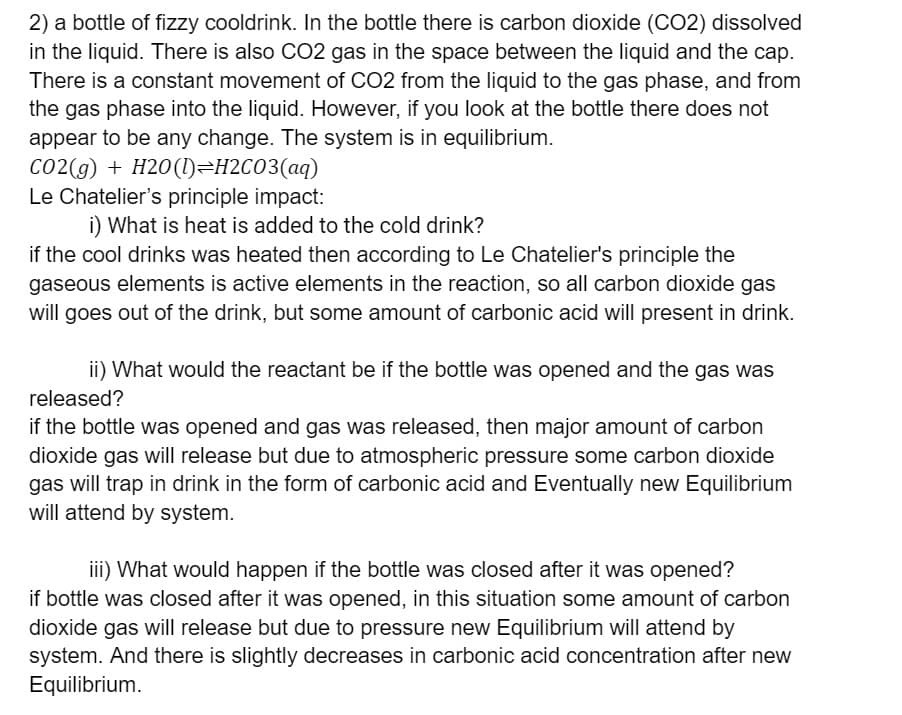Can you create an equilibrium expression for the following reaction: CO2(g)+H2O(l)⇌H2CO3(aq). Can you make an equilibrium expression for i), ii), and iii) from the image provided.
Can you create an equilibrium expression for the following reaction: CO2(g)+H2O(l)⇌H2CO3(aq). Can you make an equilibrium expression for i), ii), and iii) from the image provided.
Chemistry: The Molecular Science
5th Edition
ISBN:9781285199047
Author:John W. Moore, Conrad L. Stanitski
Publisher:John W. Moore, Conrad L. Stanitski
Chapter12: Chemical Equilibrium
Section: Chapter Questions
Problem 113QRT
Related questions
Question
Can you create an equilibrium expression for the following reaction: CO2(g)+H2O(l)⇌H2CO3(aq).
Can you make an equilibrium expression for i), ii), and iii) from the image provided.

Transcribed Image Text:2) a bottle of fizzy cooldrink. In the bottle there is carbon dioxide (CO2) dissolved
in the liquid. There is also C02 gas in the space between the liquid and the cap.
There is a constant movement of CO2 from the liquid to the gas phase, and from
the gas phase into the liquid. However, if you look at the bottle there does not
appear to be any change. The system is in equilibrium.
Co2(g) + H20(1)=H2CO3(aq)
Le Chatelier's principle impact:
i) What is heat is added to the cold drink?
if the cool drinks was heated then according to Le Chatelier's principle the
gaseous elements is active elements in the reaction, so all carbon dioxide gas
will goes out of the drink, but some amount of carbonic acid will present in drink.
ii) What would the reactant be if the bottle was opened and the gas was
released?
if the bottle was opened and gas was released, then major amount of carbon
dioxide gas will release but due to atmospheric pressure some carbon dioxide
gas will trap in drink in the form of carbonic acid and Eventually new Equilibrium
will attend by system.
iii) What would happen if the bottle was closed after it was opened?
if bottle was closed after it was opened, in this situation some amount of carbon
dioxide gas will release but due to pressure new Equilibrium will attend by
system. And there is slightly decreases in carbonic acid concentration after new
Equilibrium.
Expert Solution
This question has been solved!
Explore an expertly crafted, step-by-step solution for a thorough understanding of key concepts.
Step by step
Solved in 2 steps

Follow-up Questions
Read through expert solutions to related follow-up questions below.
Knowledge Booster
Learn more about
Need a deep-dive on the concept behind this application? Look no further. Learn more about this topic, chemistry and related others by exploring similar questions and additional content below.Recommended textbooks for you

Chemistry: The Molecular Science
Chemistry
ISBN:
9781285199047
Author:
John W. Moore, Conrad L. Stanitski
Publisher:
Cengage Learning


Chemistry: An Atoms First Approach
Chemistry
ISBN:
9781305079243
Author:
Steven S. Zumdahl, Susan A. Zumdahl
Publisher:
Cengage Learning

Chemistry: The Molecular Science
Chemistry
ISBN:
9781285199047
Author:
John W. Moore, Conrad L. Stanitski
Publisher:
Cengage Learning


Chemistry: An Atoms First Approach
Chemistry
ISBN:
9781305079243
Author:
Steven S. Zumdahl, Susan A. Zumdahl
Publisher:
Cengage Learning

Chemistry
Chemistry
ISBN:
9781305957404
Author:
Steven S. Zumdahl, Susan A. Zumdahl, Donald J. DeCoste
Publisher:
Cengage Learning

Introductory Chemistry: A Foundation
Chemistry
ISBN:
9781285199030
Author:
Steven S. Zumdahl, Donald J. DeCoste
Publisher:
Cengage Learning

Chemistry: Principles and Reactions
Chemistry
ISBN:
9781305079373
Author:
William L. Masterton, Cecile N. Hurley
Publisher:
Cengage Learning